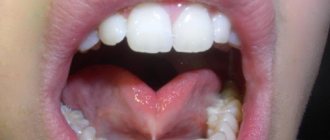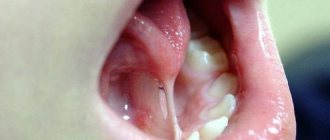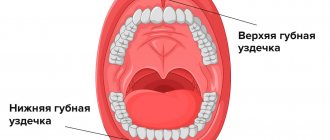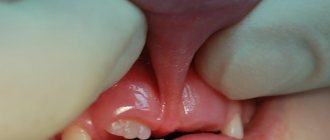Problem: for a consultation with the Dial-Dent speech therapist T.B. Zukor was contacted by a 22-year-old man. His wish: “We urgently need to trim the frenulum of the tongue! The surgeon needs a referral from a speech therapist to perform the operation!” The reason for this urgent treatment was unbearable pain in the tongue area when kissing!
Solution: myofunctional examination confirmed the need for frenuloplasty of the tongue (surgery to trim the frenulum of the tongue). The man received a referral for an operation, which was performed by surgeons at the clinic. Frenuloplasty of the tongue was successful, the pain was completely eliminated.
The speech therapist of the Family Dental T.B. talks about the short frenulum of the tongue, how to identify it, and what to do with it. Zukor in his article.
When is tongue frenulum trimming required?
The frenulum of the tongue is a small elastic membrane connecting the tongue to the oral cavity. The frenulum is responsible for important functions of the tongue: movement, breathing, swallowing, speech. This disorder is called ankylogloxia.
The normal development of the lingual frenulum begins centrally, at the root of the tongue, and ends at the lower incisors. The rest of the arrangement is a deviation. There are several deviations in the development of the frenulum:
- Short bridle. The tongue becomes inactive and leads to improperly formed speech and jaw deformation.
- Incorrectly positioned frenulum. Reduces motor activity of the tongue.
- Long frenulum under the tongue. It can be located at the tip of the tongue and affect the swallowing process, disrupting nutrition.
Problems with the development of the tongue frenulum are a congenital pathology. And it is hereditary in nature. May occur due to problems during pregnancy.
Trimming the frenulum for an adult
The operation to trim the frenulum of the tongue can be performed at any age as prescribed by a doctor.
Every 20th person has a shortened frenulum of the tongue. The likelihood of this anomaly occurring in men is much higher than in women.
To independently check how the frenulum is located under the tongue, you can do simple children’s exercises: “horse”, “mushroom”, “painter”. Externally, the frenulum will not differ from a healthy state. If you experience any discomfort while performing these exercises, you should go to the clinic for a consultation.
Symptoms that will help you identify problems with tongue webbing:
- When the tongue is extended, the tip of the tongue bends down;
- Difficulty swallowing;
- It is not possible to insert the tongue completely;
- Bite problems;
- Inflammation of the surrounding tissues of the tooth;
- When the tongue is raised, it takes the shape of a heart;
- Incorrect pronunciation of words.
Adults require frenulum trimming less often than small children. However, tissue healing in an adult takes a little longer than in small children. This type of operation is performed under local anesthesia.
When is surgery scheduled?
The frenulum circumcision operation is performed for the following indications:
- Impaired pronunciation of words. If the speech therapist did not notice the deviation in childhood, then speech defects may occur in adulthood. The operation will help restore the functioning of the speech apparatus.
- Orthodontist recommendations. A frenulum that is too short causes crooked teeth and stunts the growth of the lower jaw.
- Periodontal recommendations. Due to deformation of the gums, the root of the tooth is exposed, which makes it susceptible to other diseases.
When not to have surgery
Since all surgical procedures have limitations. If you have:
- acute chronic diseases of the oral cavity;
- benign tumors of the jaw tissue;
- infectious diseases of the whole body;
- poor blood clotting;
- mental disorder;
The operation to trim the frenulum of the tongue is called frenuloplasty.
Types of frenuloplasty
This type of operation can be performed in 3 ways:
- Cutting. The bridle is trimmed, the edges of which are sewn with transverse seams.
- Delete. The frenulum is trimmed using two triangular incisions and removed, after which sutures are applied.
- Moving. The edge of the frenulum is trimmed and secured in the required place with sutures.
The entire operation takes no more than 20 minutes. After a few days, the stitches will dissolve on their own. There are no complications after frenuloplasty.
What is a short frenulum of the tongue?
The frenulum is a thin partition that connects the tongue and the lower oral cavity. Normally, the frenulum is quite elastic, stretches well and is attached to the tongue in its middle part.
An abnormal structure may be the location of the frenulum closer to the edge of the tongue or even at its tip. In addition, a significant decrease in its elasticity, that is, its ability to stretch, is possible.
So in fact, the concept of “short bridle” is not entirely correct. Therefore, there is no clear solution to this issue.
How to check if a child has a short frenulum
The presence of difficulties with the frenulum can be easily determined independently:
- Open your mouth slightly and place the tip of your tongue in the area behind your upper teeth. In this position, the place of attachment of the frenulum is clearly visible. If it is not “where it needs to be,” it is difficult to lift the tongue up.
- Pull your tongue forward. A short frenulum does not allow this to be done; in addition, the tip of the tongue visually looks forked
- Open your mouth and try to touch your upper lip with your tongue and lick it. Difficulties with the bridle make this movement difficult to perform.
Please note: sometimes a child cannot cope with these exercises not because there is something wrong with the frenulum. The cause may be weak muscles of the articulatory apparatus. Take a clean handkerchief and try to help your tongue. If resistance is felt when moving, then the problem is still in the hyoid frenulum.
Consultation with a speech therapist teacher “Hyoid frenulum: trim or stretch?”
Evgenia Kovalevskaya
Consultation with a speech therapist teacher “Hyoid frenulum: trim or stretch?”
“Hyoid frenulum: trim or stretch?”
The sublingual frenulum is a membrane that is located under the tongue and connects the tongue to the sublingual space.
How to determine whether the hyoid frenulum is long enough?
The hyoid ligament (frenulum) can be of different lengths in different people.
Ask your child to lift his tongue up toward the hard palate. With a normal hyoid frenulum, the child freely raises the tongue to the hard palate. With a short hyoid frenulum, the child cannot stretch the tongue forward and lift the tongue upward towards the hard palate. When the child pulls his tongue up, you will see how the hyoid ligament, limiting the rise of the tongue, stretches, becomes more pronounced, protrudes more prominently under the tongue, and becomes thinner. Another reason that a child cannot lift his tongue up is that the child’s tongue muscles are not strong enough and are inactive. Then you will see how he cannot cope with the muscles, then the tongue trembles, deviates to the side, twitches, and goes down.
Normal: at 5 years of age, the frenulum in a stretched state should be at least 8 mm. The average length of the frenulum is 1.5 cm.
What does this mean?
Short hyoid frenulum:
- can cause difficulty in moving the tongue, as it does not allow it to rise high. In this case, the so-called “upper sounds” suffer, i.e. the pronunciation of sounds such as Ш, Ж, Х, Ш, Р, Рь is disrupted
- can lead to a displacement of the center of the tongue, its asymmetrical development and low mobility, which prevents the formation of the correct articulatory posture of some sounds.
- may also cause problems with sound pronunciation
– in some cases, it can provoke problems with the formation of the lower jaw, i.e. the teeth may deviate and the necks of the teeth may be exposed. There is a risk of developing periodontitis and gingivitis. Therefore, a consultation with an orthodontist is necessary.
What to do?
1. Surgery
2. Stretching the hyoid frenulum
Even if the frenulum is somewhat shortened (equal to 8 mm), it is better to stretch it than to operate, since this procedure is somewhat painful and unpleasant for the baby!
Strong indications for trimming the hyoid frenulum:
1. It is better to trim the short frenulum of the tongue at an early age, up to one year.
Indications for surgery if the child while feeding:
• the child sucks poorly at the breast due to the fact that the shortened frenulum prevents the mother from tightly clasping the nipple.
• throws back his head.
• smacks and cries when sucking.
2. At an older age, the indication is when, due to a shortened frenulum, the child’s dentition shifts and an abnormal bite is formed.
3. Difficulties in pronouncing sounds; only in some cases does it require surgical intervention. In 90% of cases, when 1-4 sounds are violated, the short frenulum of the tongue is easily stretched with the help of special articulatory gymnastics exercises.
Methods and techniques for stretching the hyoid ligament (frenulum).
MECHANISM OF EXERCISES for stretching the frenulum: since this is a fold (like a muscular, mucous fold, that is, the ability to carefully and slightly correct the initial state of the frenulum, the exercises give the tongue the opportunity to rise up, thereby gradually stretching the muscle (it is quite elastic, these exercises cannot be performed jerkily, very smoothly and slowly.
Sounds that require a noticeable upward movement of the tip of the tongue ([р], [ш], [ж]) are placed after the child’s hyoid ligament is fully stretched.
Sounds ([l], [h], [sch], [t'], [d']) can be started when the frenulum has not yet fully stretched, but there is already some upward movement of the tip of the tongue.
A short frenulum does not interfere with the normal pronunciation of other sounds of the Russian language.
It is recommended to start stretching the frenulum at an early age. All children are recommended to do gymnastics for the tongue - this will help avoid a lot of problems at 5-7 years old (talking about pronunciation).
Attention! Parents!
Before you start doing exercises to stretch the hyoid frenulum, you need to visit a speech therapist so that he can show you how to do them correctly! Your inept movements can lead to a rupture of the frenulum - and this is terribly unpleasant once, and then a knot twice.
Articulation exercises for stretching the frenulum of the tongue:
1) “Lick the saucer.”
Invite your child, like a kitten, to lick a saucer smeared with jam or something else.
You can reach for the spoon with your tongue.
2) "Swing"
Open your mouth, reach with the tip of your tongue first to your nose, and then to your chin, then again to your nose, and then again to your chin.
5) "Horse"
Smile, open your mouth. Click the tip of your tongue like a horse clicking. The mouth is open, the tongue should be wide. Make sure that the tip of the tongue does not turn inward and that the lower jaw remains motionless.
6) "Painter"
Smile, open your mouth. Using the wide tip of your tongue, stroke the palate from the teeth to the throat. The lower jaw should not move.
7) "Mushroom"
Smile, open your mouth. Suck your wide tongue to the roof of your mouth. This is the cap of the mushroom, and the hyoid ligament is the stalk. The tip of the tongue should not turn up, the lips should be in a smile. If the child is unable to suck his tongue, then he can click his tongue, as in the “Horse” exercise. Clicking trains the desired movement of the tongue.
 "Harmonic"
"Harmonic"
Position the tongue as in the “Mushroom” exercise, lips in a smile. Without lifting your tongue, open and close your mouth.
9) "Drum"
Smile, open your mouth. Repeatedly and clearly pronounce the sound D-D-D. When pronouncing this sound, the tongue rests on the upper teeth, do not close the mouth. Very often, when performing this exercise, the child closes his mouth. To prevent this from happening, you can hold a stick about 1 cm wide or the handle of a rectangular children's toothbrush between your teeth (the handle should not be thick, it should be straight, like a ruler).
10) "Football"
Close your mouth, press the tip of your tongue against one cheek, then the other, so that balls are inflated under the cheek.
11) Exercise “Mole”
Use your index fingers and thumbs to pull your tongue down by the tip.
- There is a slide in the yard, -
Use your index fingers and thumbs to pull your tongue upward by the tip.
— There is a mink under the hill. –
With your index finger, forcefully stroke the hyoid frenulum from bottom to top, stretching it.
- In this hole
— The mole is guarding the mink.
Treatment methods
Problems associated with a short frenulum of the tongue can be solved with medicinal and non-medicinal methods.
Medicinal methods involve surgical intervention of varying degrees.
If the sublingual membrane requires dissection, but it is quite thin and elastic, then the doctor dissects it right at the appointment. In this case, anesthesia is not provided, since the procedure is classified as mild.
More complex types of dissection of the frenulum of the tongue include frenulotomy, which is indicated for children with thicker frenulums. Frenulotomy is performed under local anesthesia with tissue dissection and subsequent suturing.
Complications of this operation may include stomatitis, prolonged bleeding from the wound, infection in the wound, etc. After frenulotomy, the child should receive pureed food for some time, as chewing may be painful.
Non-drug treatment methods include special types of massage, exercises to correct the frenulum of the tongue, and individual sessions with a speech therapist.
Non-drug methods are recommended when the condition of the child’s tongue frenulum is not critical and allows refusal of surgery. The decision on this is made by a speech therapist, pediatrician and dentist. Classes with a speech therapist include various exercises, articulation gymnastics, tongue twisters and poems.
Since a short frenulum of the tongue causes some speech defects, classes with a speech therapist are necessary both in the postoperative period and as a correction.
A massage aimed at stretching the frenulum of the tongue includes a list of special exercises. It is important that the classes are systematic so that they give a positive result.
Massage instead of cutting the frenulum is recommended for children in two cases: if the condition of the frenulum is not so critical and the problem can be solved with non-drug treatment methods; if the frenulum is cut when the child is older (over 5 years old) and the surgery will not solve problems with speech impediment.
How does a short frenulum of the foreskin manifest itself?
The clinical manifestations of this defect can be more or less pronounced, depending on its degree. They are as follows:
- strong tension of the frenulum in the erect state of the penis and the development of pain (including during sexual intercourse);
- insufficient filling of the cavities of the cavernous bodies with blood and, as a result, insufficient increase in the volume of the penis and its hardening;
- strong curvature of the penis towards the scrotum, making sexual intercourse very difficult (or even completely inaccessible);
- development of sexual dysfunction, in which ejaculation occurs too quickly;
- damage to the frenulum during sexual intercourse in the form of cracks and tears with bleeding.
We should not forget that the inability to move skin folds significantly complicates hygiene measures and favors the stagnation of smegma. As a result, serious inflammatory processes develop, which aggravate the situation. Frequent traumatic injuries are accompanied by scarring and even greater shortening of the frenulum, and as a result, they can provoke the development of secondary infectious processes (including those that are sexually transmitted).
An important indicator is the psychological state of the patient. He suffers from neurotic disorders and is afraid of sexual intercourse. Such manifestations further aggravate the situation, provoking erectile dysfunction at the psychogenic level.
Who to contact for help
Depending on the complexity of the situation, an orthodontist or speech therapist will help you cope with the problem. In any case, it makes sense to first get a consultation to decide what method of correction the child needs.
The dentist will carefully trim the frenulum, relieving the child of discomfort with one movement of his hand. However, recently doctors still recommend leaving surgical intervention as a last resort. An experienced speech therapist will offer a set of exercises and massage to stretch the frenulum.
Experts say that there are not many situations when the hyoid frenulum is absolutely unable to stretch. In almost all cases, a conservative approach achieves results.
Parents can evaluate the pros and cons of different approaches on their own.
Surgical method:
- A quick, radical solution to the problem.
- The operation is performed using anesthesia.
- The healing process takes some time and is uncomfortable.
- Dietary restrictions due to surgery.
- It is advisable to maintain vocal rest for several days.
- Psychological trauma in the child is possible.
- After the operation, classes with a speech therapist are necessary to correct sound pronunciation.
Frenum stretching method:
- Conservative, does not cause psychological difficulties in the child.
- Effective in most cases.
- Does not require changes to your usual routine.
- It takes some time (several months).
- Requires discipline and regular practice.
In any case, to resolve the issue, you need to consult a speech therapist.
What is the problem with the incorrect structure of the frenulum of the tongue?
In infants, an abnormal frenulum structure can cause difficulty sucking. In this case, the problem is solved in the maternity hospital by pruning. If the baby is still able to eat normally, doctors try to leave the situation alone, giving, as they say, time to grow. Indeed, in many cases, along with the growth of the jaw, the frenulum gradually stretches and takes on a normal shape.
In older children, a short hyoid frenulum creates some speech therapy difficulties:
- Difficulties arise with the pronunciation of hissing sounds.
- Correct reproduction of sonorants is not possible.
To pronounce the so-called upper lingual sounds, you need to raise the tip of your tongue upward. An insufficiently elastic bridle prevents this from being done.
However, it is very important to understand that it is not “responsible” for all speech problems. So if a child has a delay in speech development, syllables and sounds are “confused” in speech, a limited vocabulary or other problems, a short frenulum has nothing to do with it. The speech therapist will suggest effective methods of correction.










